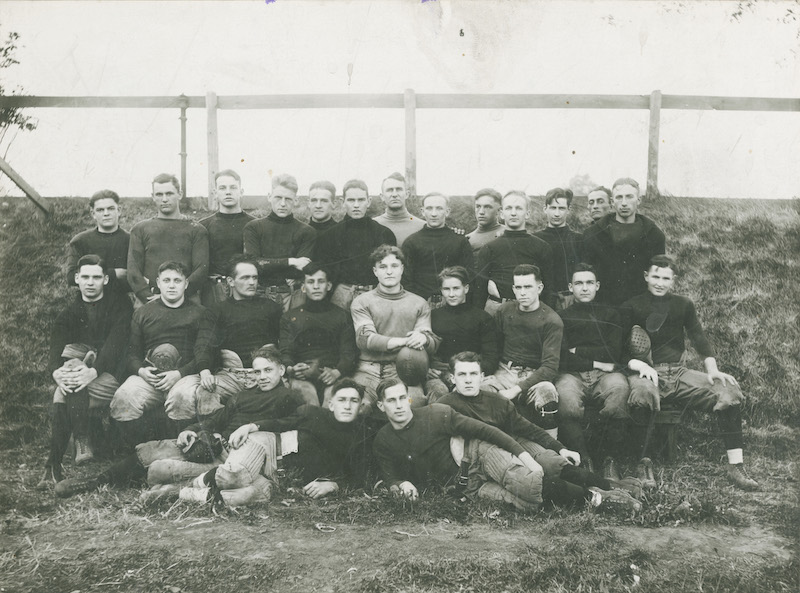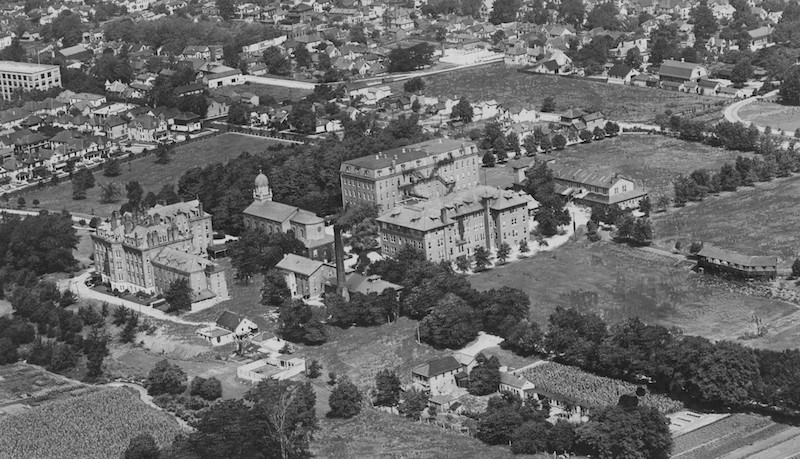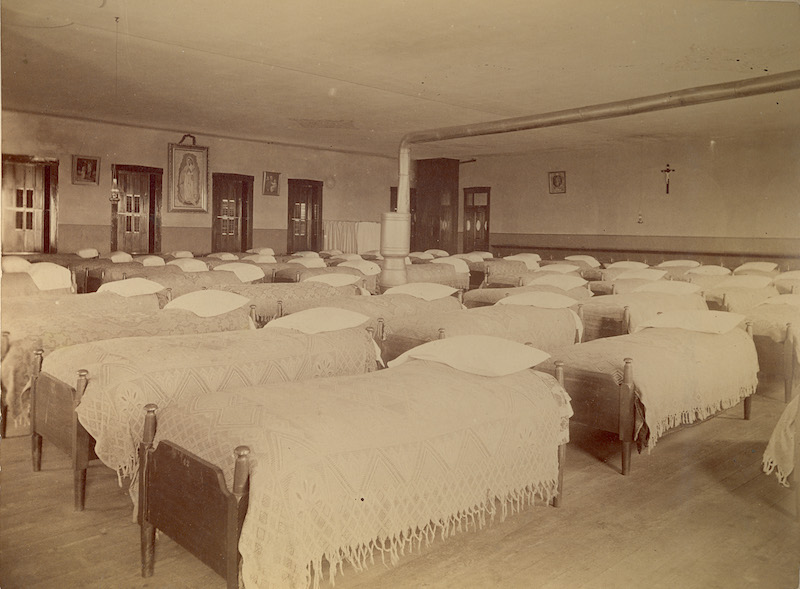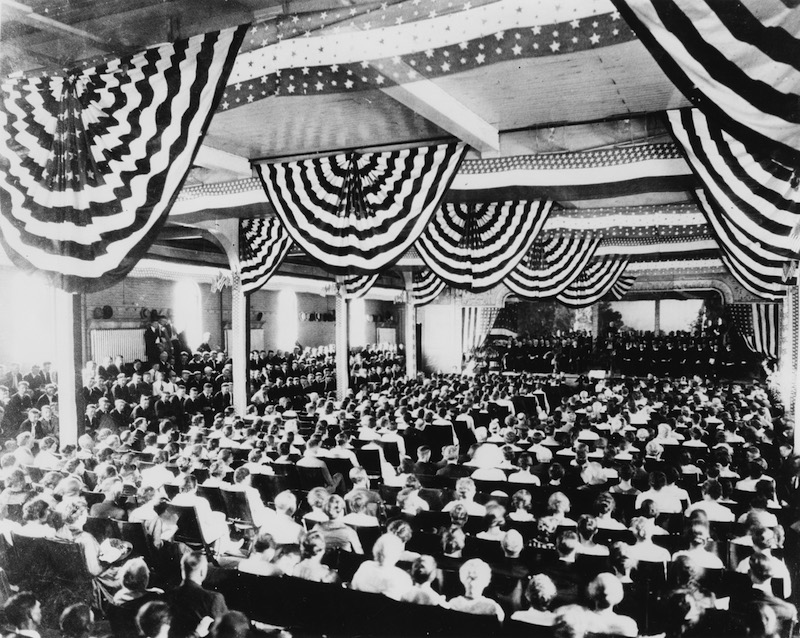University Libraries

Pandemics: UD Archivist Looks Back … and Forward
By Kristina Schulz
Since the World Health Organization declared the coronavirus a pandemic on March 11, time seems to move slowly, even as circumstances change by the hour. Our lives have been altered in the ways we work, study, learn and socialize.
This is not Dayton’s first experience with a pandemic, yet we don’t have a lot in University Archives to draw from in interpreting what this was like and how the University — then known as St. Mary’s College — responded. Here, we offer a look back at what information we have and make an appeal to the community to create an archive of the present pandemic for future generations.
The 1918 flu pandemic
Very few people still living had been born yet when the pandemic of what’s historically known as Spanish influenza arrived in the spring of 1918, though we may have grandparents or great-grandparents who lived through it. We might also have had relatives who did not survive it.
In the spring of 1918, St. Mary’s College, now the University of Dayton, had just finished a series of three celebrations commemorating the centenary of the founding of the Society of Mary. On Dec. 11, 1817, seven sodalists of the Blessed Virgin — the first seven Marianist brothers — had made their profession to “consecrate their lives entirely to God” under the direction of Father William Joseph Chaminade, the order’s founder (The Exponent, January-February 1918, p. 468).
These three celebrations — Nazareth Day, Foundation Day and College Day — took place in late 1917 on the St. Mary’s campus. In addition to recounting these commemorative events, the early 1918 issues of the College magazine, The Exponent, focused on the local experience of World War I. A column in the January issue, “With the Army and Navy,” offers news of St. Mary’s students and alumni in the armed services. Articles titled “War Sacrifices,” “With Whom is our Quarrel?” and “Who are the Patriots Today?” fill the March 1918 issue of the magazine.
First mention in ‘Exponent’: October 1918
The first wave of the pandemic struck the United States in the spring, primarily affecting military installations. The spring issues of The Exponent contain no mention of influenza. Evidence of the effects of influenza on the campus does not appear in the magazine until October 1918 in the obituaries and the athletics section. As the October magazine was being prepared for publication, the staff received word that two Marianist brothers had died of influenza while visiting other U.S. cities. That issue also shows an obituary for Michael A. Daughtery, a 1909 St. Mary’s Institute graduate from Lancaster, Ohio, who died on Oct. 10 (p. 292).
The athletics section of the October issue contains a report about the SMC football game against the Naval Reserve team on Oct. 12. Staff offered additional perspective on the football season:
“It is unfortunate, however, that war and other conditions have put a damper on the playing season, by interfering with the schedules and the well-laid plans of the coaches. Already the ‘Flu’ in the neighboring camps has prevented the soldier squad from taking a fall out of Antioch and the Aviators from Wright Field, and the Earlham game, scheduled for the 19th was cancelled for the same reason” (p. 294).
Closings, disruptions
Changes in the daily lives of Daytonians became radically different in early October of 1918. On Oct. 9, the Dayton Daily News reported that Dr. A.O. Peters, Dayton’s commissioner of health, ordered schools closed (p.1). Saloons, churches, and pool halls were also closed under the orders; however, saloons later opened up for carryout of bottled items within a few days of the mandated closings. The article also announced that “reading rooms of the public library have been closed pending further orders.”
One of the few mentions of St. Mary’s College in the Dayton Daily News was in the sports section on Nov. 22, 1918. The article with the headline “Closing St. Mary College compels Saints to cancel game with Wilbur Wright” indicates that St. Mary’s was closed due to influenza, forcing the school to cancel its scheduled football game. The December 1918 issue of The Exponent reports that SMC played only two football games the entire season.
The pandemic disrupted other St. Mary’s activities as well. The Exponent did not publish in November 1918. When the magazine resumed publication with the December issue, obituaries began to trickle in to the editors. Obituary sections from December 1918 through March 1919 listed nine influenza deaths among alumni, many of them in their 20s and 30s. However, this was not a comprehensive list of pandemic fatalities in the SMC community; obituaries only appeared for alumni or students whose families notified St. Mary’s of the loved ones’ deaths.
War and graduation coverage
Coverage of commencement day, June 12, 1919, appeared in the July issue of The Exponent. The salutatory, valedictory and commencement addresses extolled the virtues of the College and described the outcome of the war (now known as World War I) and its place in history but did not mention influenza (pp. 349-362).
The College magazine is filled with news of World War I and the peace that followed. The students and alumni who served during the war are honored in the pages of the college magazine in a section titled “The Stars in our Service Flag.”
Gap of silence: Let us not repeat it
The dearth of commentary on the 1918 flu pandemic leaves a gap of silence in the cultural history of the University and St. Mary's College.
Let’s not repeat this silence. What type of story will we write about the pandemic of 2020 and how it affected the University of Dayton?
As members of the campus community, I invite faculty, staff and students to share their stories. How has this changed the ways you work, teach, learn and engage with our community? Please share by using this Google form and uploading content.
More information about the 1918 pandemic
Spanish influenza statistics:
- 675,000 Americans died
- 500 million people infected worldwide
- Estimated deaths worldwide: 20 million to 50 million
Influenza also reached pandemic level in 1957-58 (116,000 U.S. deaths) and 1968-69 (100,000 U.S. deaths). Additional information:
Bibliography
“Churches, Schools, Movies, Saloons Ordered Closed”. Dayton Daily News, October 9, 1918. Accessed 3/23/2020. https://www.newspapers.com/image/397687234
“Dayton, Ohio and the 1918-1919 Influenza Epidemic.” The American Influenza Epidemic of 1918: A Digital Encyclopedia, University of Michigan Library, 2016. Accessed 3/22/2020. https://www.influenzaarchive.org/cities/city-dayton.html
Frederick, Jackie. “An Epidemic Checked: A Chronicle of the 1918 Influenza Pandemic in Dayton, Ohio.” Dayton History Books Online, 2003. Accessed 3/22/2020. https://www.daytonhistorybooks.com/page/page/2753646.htm
Gladwell, Malcolm. “The Deadliest Virus Ever Known.” The New Yorker. Last modified September 22, 1997. Accessed 3/22/2020. https://www.newyorker.com/magazine/1997/09/29/the-dead-zone
“McCook-Navy Contest only Local Football Tilt, Saturday Afternoon." Dayton Daily News, November 22, 1918. Accessed 3/23/2020. https://newspapers.com/image/397675092
Taubenberger, J.K. and D.M. Morens. “1918 Influenza: The Mother of All Pandemics”. Emerging Infectious Diseases. 2006:12(1):15-22. Accessed 3/22/2020. https://wwwnc.cdc.gov/eid/article/12/1/05-0979_article
St. Mary’s College. The Exponent. Vol. 15. Dayton, OH: St. Mary’s College, 1918.
St. Mary’s College. The Exponent. Vol. 16. Dayton, OH: St. Mary’s College, 1919.
— Kristina Schulz is the University archivist.



